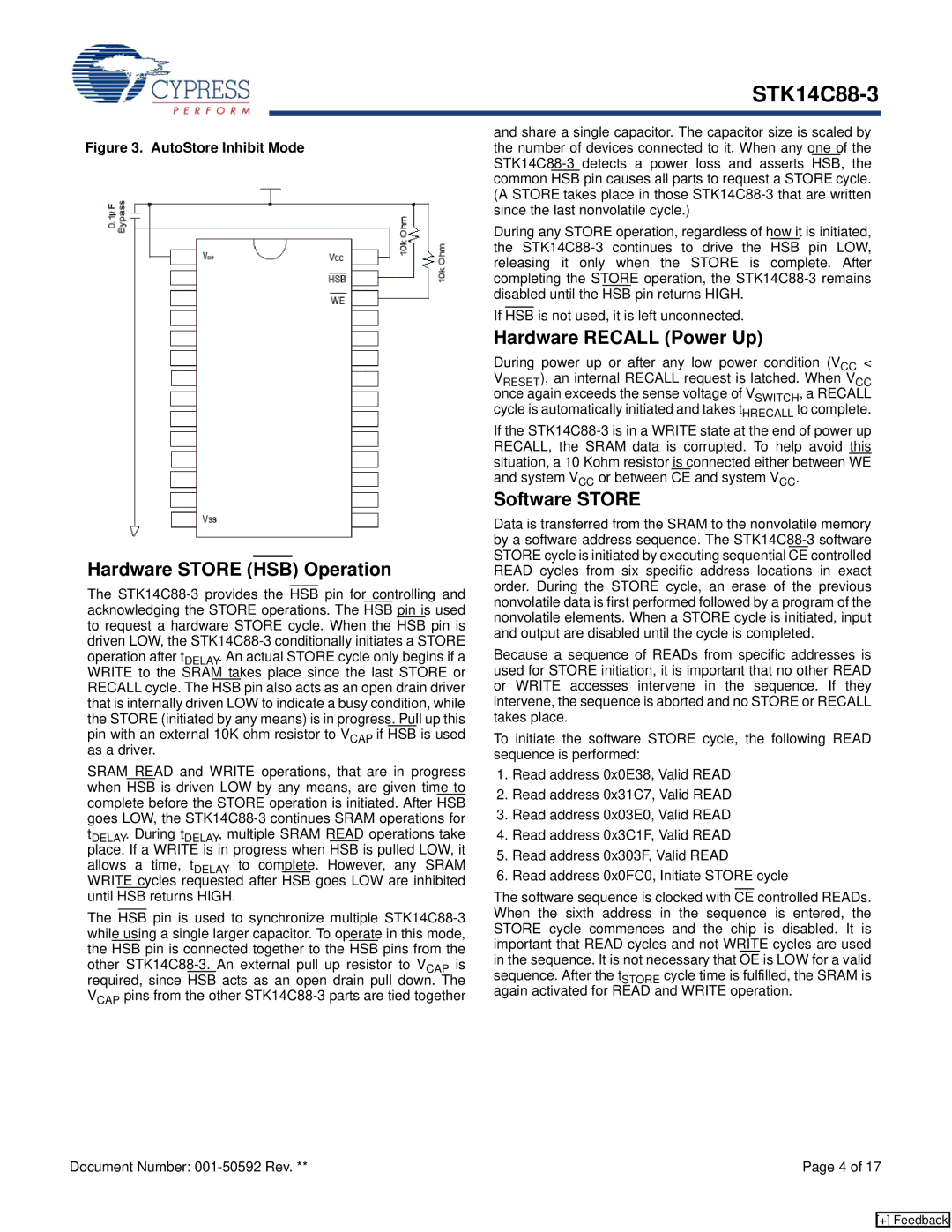Figure 3. AutoStore Inhibit Mode
Hardware STORE (HSB) Operation
The STK14C88-3 provides the HSB pin for controlling and acknowledging the STORE operations. The HSB pin is used to request a hardware STORE cycle. When the HSB pin is driven LOW, the STK14C88-3 conditionally initiates a STORE operation after tDELAY. An actual STORE cycle only begins if a WRITE to the SRAM takes place since the last STORE or RECALL cycle. The HSB pin also acts as an open drain driver that is internally driven LOW to indicate a busy condition, while the STORE (initiated by any means) is in progress. Pull up this pin with an external 10K ohm resistor to VCAP if HSB is used as a driver.
SRAM READ and WRITE operations, that are in progress when HSB is driven LOW by any means, are given time to complete before the STORE operation is initiated. After HSB goes LOW, the STK14C88-3 continues SRAM operations for tDELAY. During tDELAY, multiple SRAM READ operations take place. If a WRITE is in progress when HSB is pulled LOW, it allows a time, tDELAY to complete. However, any SRAM WRITE cycles requested after HSB goes LOW are inhibited until HSB returns HIGH.
The HSB pin is used to synchronize multiple STK14C88-3 while using a single larger capacitor. To operate in this mode, the HSB pin is connected together to the HSB pins from the other STK14C88-3. An external pull up resistor to VCAP is required, since HSB acts as an open drain pull down. The VCAP pins from the other STK14C88-3 parts are tied together
and share a single capacitor. The capacitor size is scaled by the number of devices connected to it. When any one of the STK14C88-3 detects a power loss and asserts HSB, the common HSB pin causes all parts to request a STORE cycle. (A STORE takes place in those STK14C88-3 that are written since the last nonvolatile cycle.)
During any STORE operation, regardless of how it is initiated, the STK14C88-3 continues to drive the HSB pin LOW, releasing it only when the STORE is complete. After completing the STORE operation, the STK14C88-3 remains disabled until the HSB pin returns HIGH.
If HSB is not used, it is left unconnected.
Hardware RECALL (Power Up)
During power up or after any low power condition (VCC < VRESET), an internal RECALL request is latched. When VCC once again exceeds the sense voltage of VSWITCH, a RECALL cycle is automatically initiated and takes tHRECALL to complete.
If the STK14C88-3 is in a WRITE state at the end of power up RECALL, the SRAM data is corrupted. To help avoid this situation, a 10 Kohm resistor is connected either between WE and system VCC or between CE and system VCC.
Software STORE
Data is transferred from the SRAM to the nonvolatile memory by a software address sequence. The STK14C88-3 software STORE cycle is initiated by executing sequential CE controlled READ cycles from six specific address locations in exact order. During the STORE cycle, an erase of the previous nonvolatile data is first performed followed by a program of the nonvolatile elements. When a STORE cycle is initiated, input and output are disabled until the cycle is completed.
Because a sequence of READs from specific addresses is used for STORE initiation, it is important that no other READ or WRITE accesses intervene in the sequence. If they intervene, the sequence is aborted and no STORE or RECALL takes place.
To initiate the software STORE cycle, the following READ sequence is performed:
1.Read address 0x0E38, Valid READ
2.Read address 0x31C7, Valid READ
3.Read address 0x03E0, Valid READ
4.Read address 0x3C1F, Valid READ
5.Read address 0x303F, Valid READ
6.Read address 0x0FC0, Initiate STORE cycle
The software sequence is clocked with CE controlled READs. When the sixth address in the sequence is entered, the STORE cycle commences and the chip is disabled. It is important that READ cycles and not WRITE cycles are used in the sequence. It is not necessary that OE is LOW for a valid sequence. After the tSTORE cycle time is fulfilled, the SRAM is again activated for READ and WRITE operation.

